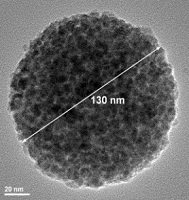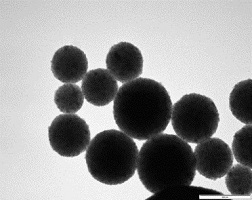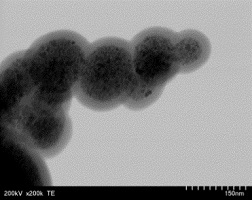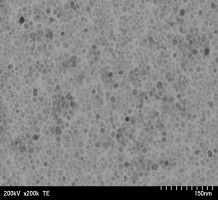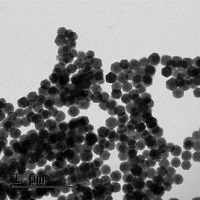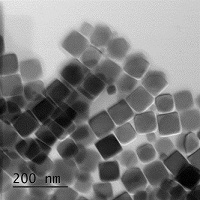The team Multifunctional materials and biologically active compounds has expertise in advanced materials and develops research related to the synthesis, characterization and applications of functionalized hybrid nanostructures, polymers and bioactive compounds with controlled properties.
Research topics
- Functionalized hybrid nanostructures based on magnetic nanoparticles and organic compounds
- Smart magnetic micro / nanogels for applications in biotechnology and nanomedicine
- Magnetic nanoparticles and magnetic clusters with controlled properties for applications in magnetic separation, depollution, nanomedicine and security
- New polymers / copolymers with special properties for applications in the pharmaceutical industry and medicine
- Complex characterization of multifunctional materials: nanostructure-properties correlation, properties changes in response to external stimuli, specific interactions with biomolecules and certain drugs, recyclability (X-ray photoelectron spectroscopy (XPS), FTIR spectroscopy, Raman spectroscopy; EELS spectroscopy); determination of the position on an absolute scale (with respect to the vacuum) of the valence and conduction bands using XPS, UPS and UV-vis methods on semiconductor nanoparticles
- Synthesis of nanomaterials with controlled properties, using environmentally friendly reagents
- Magnetic nanoparticles and carbon structures modified with metal oxides – synthesis and characterization. Applications in depollution and medicine
- Extraction and characterization of bioactive compounds from plants
- Improving the quality of cosmetic products using natural plant extracts with antioxidant and photoprotective properties
- Application of plant extracts to improve the quality of food
- Applications of nanomaterials and bioactive compounds for depollution
- Applications of chromatographic (HPLC, TLC) and spectrophotometric (UV-Vis) methods in analyzing pollutants in the environment and determining the quality of medicines, the quality of food, the purity of synthesized organic and organometallic compounds
- Determining the influence of stress factors on plant development and bioactive compounds in plants
Team Leader
Dr. Alexandrina Emilia NAN – Scientific Researcher I
Expertise: Science and Engineering of Materials and Nanomaterials, Organic Chemistry.
Members:
Dr. Alexander BUNGE – Scientific Researcher III
Expertise: Organic Chemistry, Chemical Synthesis, Materials Chemistry.
Dr. Izabell CRĂCIUNESCU – Technological Development Engineer II
Expertise: Materials chemistry, Electrochemistry.
Amalia CRIȘAN – Technician
PhD student eng. Iolanda Veronica GANEA – Scientific Researcher
Expertise: Environmental Science and Engineering, Ecotoxicology, Management of Risks and Natural/Technological Disasters, Soil and Water Decontamination, Integrated Analysis of Sediments.
PhD student George-Marian ISPAS – Scientific Researcher
Expertise: Environmental Science.
Prof. Dr. Jürgen LIEBSCHER – Scientific Researcher I
Expertise: Organic Chemistry, Heterocyclic chemistry, Polydopamine chemistry, Magnetic nanostructures, Organocatalysis, Ionic liquids, Analogues of natural products, Lipid – nucleic acid conjugates.
Dr. Ildiko LUNG – Scientific Researcher III
Expertise: Analitycal Chemistry, Environmental Science, Nanomaterials.
Ildiko MACAVEI – Technician
Dr. Ocsana Ileana OPRIŞ – Scientific Researcher II
Expertise: Chemistry, Analytical chemistry, Chromatography, Environmental Science.
Dr. Anca Cristina PETRAN – Scientific Researcher II
Expertise: Polymers Chemistry, Organic Chemistry, Composite Material.
Dr. Stelian Gheorghe PINTEA – Scientific Researcher III
Expertise: Materials physics/science, Surface/interface physics.
Dr. eng. Mircea Nicolae POP – Scientific Researcher III
Expertise: Electronics – analysis and design, Microcontroller or FPGA based esmbedded systems, Experimental physics, Calorimetry- theory and experiment, Measurement and monitoring meant instrumentation.
Dr. Teodora Maria RADU – Scientific Researcher II
Expertise: Materials science, Spectroscopy: XPS, UPS , EELS.
Dr. Maria Loredana SORAN – Scientific Researcher I
Expertise: Analytical chemistry, Environmental sciences, Plant sciences, Nanomaterials.
Dr. Olimpia Adina STEGĂRESCU – Scientific Researcher II
Expertise: Chemistry.
Dr. Natalia TERENTI – Scientific Researcher
Expertise: Coordination chemistry (homo- and heterometallic complexes, coordination polymers with various applications), Organic Solar Cells (OSCs), Porous materials (COFs, PAFs, MOFs).
Dr. Rodica Paula TURCU – Scientific Researcher I
Expertise: Materials Science, Nanomaterials, Condensed Matter Physics.
Poly(benzofurane-co-arylacetic acid) – a new type of highly functionalized polymers
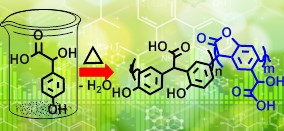 4-Hydroxymandelic acid a typical α-hydroxy acid was polymerized by thermal treatment. Surprisingly, instead of the commonly observed polyester formation (e. g. in case of lactic or glycolic acid), C-C-bond connection between the phenolic units of 4-hydroxymandelic acid, by Friedel-Crafts alkylation, occurred resulting in polymers containing carboxylic and phenolic moieties. In addition, lactone formation by reaction between phenol and carboxyl groups in appropriate positions took place leading to benzofuranone units in the final polymer. Thus, poly(benzofurane-co-arylacetic acid) structures, a novel type of organic polymer, were obtained. Interestingly, branching of the polymer chain was also detected. Detailed analysis of these polymerized 4-hydroxymandelic acids (PHMA) by spectroscopic methods revealed formation of oligomers up to 15-mers. Moreover, the three reactive units (acid, phenol, lactone) in the structureof PHMA provide orthogonal reactivity: i) lactone rings reacted with 7-amino-4-methylquinolin-2(1H)-one by amide bond formation. ii) phenol groups were O and/or C-propargylated by reaction with propargyl bromide. iii) Propargylated as well as unmodified PHMA were used as coating for magnetite nanoparticles by Steglich esterification exploiting the carboxyl reactivity of the PHMA. Propargylated products were submitted to CuAAC click reaction in order to link functions of potential practical interest in nanomedicine and organocatalysis. The extreme easiness of preparation and the widespread reactivity render PHMA attractive for many applications.
4-Hydroxymandelic acid a typical α-hydroxy acid was polymerized by thermal treatment. Surprisingly, instead of the commonly observed polyester formation (e. g. in case of lactic or glycolic acid), C-C-bond connection between the phenolic units of 4-hydroxymandelic acid, by Friedel-Crafts alkylation, occurred resulting in polymers containing carboxylic and phenolic moieties. In addition, lactone formation by reaction between phenol and carboxyl groups in appropriate positions took place leading to benzofuranone units in the final polymer. Thus, poly(benzofurane-co-arylacetic acid) structures, a novel type of organic polymer, were obtained. Interestingly, branching of the polymer chain was also detected. Detailed analysis of these polymerized 4-hydroxymandelic acids (PHMA) by spectroscopic methods revealed formation of oligomers up to 15-mers. Moreover, the three reactive units (acid, phenol, lactone) in the structureof PHMA provide orthogonal reactivity: i) lactone rings reacted with 7-amino-4-methylquinolin-2(1H)-one by amide bond formation. ii) phenol groups were O and/or C-propargylated by reaction with propargyl bromide. iii) Propargylated as well as unmodified PHMA were used as coating for magnetite nanoparticles by Steglich esterification exploiting the carboxyl reactivity of the PHMA. Propargylated products were submitted to CuAAC click reaction in order to link functions of potential practical interest in nanomedicine and organocatalysis. The extreme easiness of preparation and the widespread reactivity render PHMA attractive for many applications.
[1]. A. Nan,* A. Bunge,* M. Cîrcu, A. Petran, N. D. Hădade and X. Filip, Polymer Chemistry, Vol. 8, 3504–3514 (2017)
Clean production of new functional coatings of magnetic nanoparticles from sustainable resources
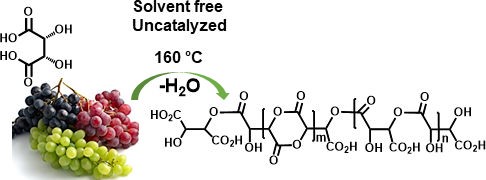 Magnetic nanoparticles coated with functional polymers play an important role in clean ways of catalysis and water treatment as well as in nanomedicine. Known systems either contain only terminal functions or polymers with pendant positively charged groups. Poly(tartaric acid) (PTA) as a new polymer with multiple pendant negatively charged carboxylate groups was pursued useful for coating magnetic nanoparticles. Simple heating of tartaric acid as a sustainable natural product without using a solvent or a catalyst under controlled conditions leads to poly(tartaric acid). The reaction runs in the solid state by elimination of water and traces of carbon oxides. The structure of the resulting poly(tartaric acid) consists mainly of polyester moieties with pendant carboxyl groups and some lactide units. It was elucidated by mass spectrometry, solid-state 13C nuclear magnetic resonance (13C ss-NMR) and Fourier-transform infrared spectroscopy (FTIR). The properties of the products depend in part on the type of starting materials (L-tartaric acid or D,L-tartaric acid). Pendant carboxyl and hydroxyl groups provide hydrophilicity and the possibility to link functions of interest. The PTA was used as new functional coatings for magnetite nanoparticles in a clean way by mixing the components and magnetic separation. The chemical stability of the magnetic nanoparticles covered by PTA was studied by UV-VIS spectroscopy in water for three weeks. Further linkage of amino-containing entities of practical interest was demonstrated by covalently binding of glucosamine.
Magnetic nanoparticles coated with functional polymers play an important role in clean ways of catalysis and water treatment as well as in nanomedicine. Known systems either contain only terminal functions or polymers with pendant positively charged groups. Poly(tartaric acid) (PTA) as a new polymer with multiple pendant negatively charged carboxylate groups was pursued useful for coating magnetic nanoparticles. Simple heating of tartaric acid as a sustainable natural product without using a solvent or a catalyst under controlled conditions leads to poly(tartaric acid). The reaction runs in the solid state by elimination of water and traces of carbon oxides. The structure of the resulting poly(tartaric acid) consists mainly of polyester moieties with pendant carboxyl groups and some lactide units. It was elucidated by mass spectrometry, solid-state 13C nuclear magnetic resonance (13C ss-NMR) and Fourier-transform infrared spectroscopy (FTIR). The properties of the products depend in part on the type of starting materials (L-tartaric acid or D,L-tartaric acid). Pendant carboxyl and hydroxyl groups provide hydrophilicity and the possibility to link functions of interest. The PTA was used as new functional coatings for magnetite nanoparticles in a clean way by mixing the components and magnetic separation. The chemical stability of the magnetic nanoparticles covered by PTA was studied by UV-VIS spectroscopy in water for three weeks. Further linkage of amino-containing entities of practical interest was demonstrated by covalently binding of glucosamine.
[1]. A. Nan*, X. Filip, M. Dan, O. Marinca, Journal of Cleaner Production, Vol. 210, 687-696 (2019)
Magnetic microgels, a promising candidate for enhanced magnetic adsorbent particles in bioseparation
 For specific applications in the field of high gradient magnetic separation of biomaterials, magnetic nanoparticle clusters of controlled size and high magnetic moment in an external magnetic field are of particular interest. High magnetization magnetic microgels with superparamagnetic behaviour have been obtained in a two-step synthesis procedure by miniemulsion technique using highly stable ferrofluid on volatile nonpolar carrier. Spherical clusters of closely packed hydrophobic oleic acid coated magnetite nanoparticles were coated with cross linked polymer shells of polyacrylic acid, poly-N-isopropylacrylamide, poly-3 -acrylamidopropyl trimethylammonium chloride. The experiments using High Gradient Magnetic Separator show high values of the separation efficiency (99.9 – 99.97%) for the magnetic microgels.
For specific applications in the field of high gradient magnetic separation of biomaterials, magnetic nanoparticle clusters of controlled size and high magnetic moment in an external magnetic field are of particular interest. High magnetization magnetic microgels with superparamagnetic behaviour have been obtained in a two-step synthesis procedure by miniemulsion technique using highly stable ferrofluid on volatile nonpolar carrier. Spherical clusters of closely packed hydrophobic oleic acid coated magnetite nanoparticles were coated with cross linked polymer shells of polyacrylic acid, poly-N-isopropylacrylamide, poly-3 -acrylamidopropyl trimethylammonium chloride. The experiments using High Gradient Magnetic Separator show high values of the separation efficiency (99.9 – 99.97%) for the magnetic microgels.
[1]. Rodica Turcu*, Vlad Socoliuc, Izabell Crăciunescu, Anca Petran, Anja Paulus, Matthias Franzreb, Eugeniu Vasile and Ladislau Vekas, Soft Matter 11, 1008-1018 (2015)
From high colloidal stability ferrofluids to magnetorheological fluids: tuning the flow behavior by magnetite nanoclusters
 The flow behavior of practically structureless ferrofluids was tuned over a large range by adding well-defined amounts of magnetite nanoparticle clusters. Magnetite nanoparticle clusters with hydrophobic coating were dispersed in high colloidal stability transformer oil based ferrofluid samples, initially free of clusters. The resulting ferrofluid composition consists both of single (approx. 7 nm mean size) and clustered (280 nm average size) magnetite nanoparticles. The magnetite nanoparticle clusters obtained by a solvothermal method have a saturation magnetization of 75 emu g−1 and a remnant magnetization of 0.2 emu g−1 due to the large size (∼25 nm) of the magnetite nanoparticles in their composition. The bidisperse magnetic nanocomposite suspensions investigated provide a promising new formulation of magnetorheological fluids with improved kinetic stability to be used in seismic dampers and flow control devices.
The flow behavior of practically structureless ferrofluids was tuned over a large range by adding well-defined amounts of magnetite nanoparticle clusters. Magnetite nanoparticle clusters with hydrophobic coating were dispersed in high colloidal stability transformer oil based ferrofluid samples, initially free of clusters. The resulting ferrofluid composition consists both of single (approx. 7 nm mean size) and clustered (280 nm average size) magnetite nanoparticles. The magnetite nanoparticle clusters obtained by a solvothermal method have a saturation magnetization of 75 emu g−1 and a remnant magnetization of 0.2 emu g−1 due to the large size (∼25 nm) of the magnetite nanoparticles in their composition. The bidisperse magnetic nanocomposite suspensions investigated provide a promising new formulation of magnetorheological fluids with improved kinetic stability to be used in seismic dampers and flow control devices.
[1]. Daniela Susan-Resiga, V Socoliuc*, A Bunge, Rodica Turcu* and L Vékás, Smart Materials and Structures 28, 115014 (2019)
The efficiency of the multi-walled carbon nanotubes used for antibiotics removal from wastewaters generated by animal farms

 The efficiency of several types of multi-walled carbon nanotubes (MWCNTs) were tested for the retention of the selected antibiotics (ampicillin, ceftazidime, cefepime, imipenem, piperacillin, tazobactam, tetracycline, erythromycin, ciprofloxacin, norfloxacin, vancomycin, gentamicin) from wastewater samples. The retention percentages of the selected antibiotics from waters ranged between ∼40 and 97%. The best percentages of retention were obtained for norfloxacin 97.03% and ciprofloxacin 97.10%. The suspensions of the MWCNTs improved the removal of the antibiotic from wastewaters.
The efficiency of several types of multi-walled carbon nanotubes (MWCNTs) were tested for the retention of the selected antibiotics (ampicillin, ceftazidime, cefepime, imipenem, piperacillin, tazobactam, tetracycline, erythromycin, ciprofloxacin, norfloxacin, vancomycin, gentamicin) from wastewater samples. The retention percentages of the selected antibiotics from waters ranged between ∼40 and 97%. The best percentages of retention were obtained for norfloxacin 97.03% and ciprofloxacin 97.10%. The suspensions of the MWCNTs improved the removal of the antibiotic from wastewaters.
M.L. Soran, O. Opriş, I. Lung, I. Kacso, A.S. Porav, M. Stan, Environ. Sci. Pollut. Res. 2017, 24(19), 16396–16406.
Effect of lipophilic sea buckthorn extract on cream cheese properties

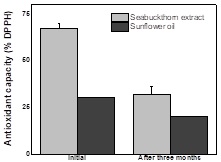 The optimized lipophilic extract of sea buckthorn was added as colorant into the cream cheese. Following the addition of the extract, it was found that the cream cheese was positively influenced by sea buckthorn lipophilic extracts increasing the antiradical activity and inhibiting the growth of the germ in the cream cheese. Moreover, the addition of sea buckthorn extracts did not adversely affect the sensory characteristics of the product. This research demonstrates the possibility of using sea buckthorn lipophilic extract in the production of functional foods. A particular interest is the possibility of replacing synthetic antioxidants with natural ones obtained from local horticultural sources in order to provide consumers with safe and stable food products.
The optimized lipophilic extract of sea buckthorn was added as colorant into the cream cheese. Following the addition of the extract, it was found that the cream cheese was positively influenced by sea buckthorn lipophilic extracts increasing the antiradical activity and inhibiting the growth of the germ in the cream cheese. Moreover, the addition of sea buckthorn extracts did not adversely affect the sensory characteristics of the product. This research demonstrates the possibility of using sea buckthorn lipophilic extract in the production of functional foods. A particular interest is the possibility of replacing synthetic antioxidants with natural ones obtained from local horticultural sources in order to provide consumers with safe and stable food products.
A. Ghendov-Moșanu, R. Sturza, O. Opriș, I. Lung, L. Popescu, V. Popovici, M.L. Soran, A. Patras, J. Food. Sci. Technol., 2019, https://doi.org/10.1007/s13197-019-04094-w.
Magnetic clusters with controlled properties
Autors: Izabell Crăciunescu, Rodica Turcu
Magnetic clusters represent controlled assembly of magnetic nanoparticles with controlled structural, morphological and magnetic properties from the synthesis parameters, which maintain their superparamagnetic properties, having high magnetic moments.
Within our research group we optimized the mini emulsion method in which we obtain assembly of magnetic nanoparticles in the form of clusters with adjustable size in a wide range 50-500 nm, with high magnetic moment, with very good chemical stability and good dispersion properties in liquid media. The synthesis procedure ensures very good reproducibility of magnetic clusters and allows for large scale production. Modifying surface properties by coating with different inorganic or organic polymeric layers, or various molecules with specific functions offers the perspective of using magnetic clusters towards a variety of innovative applications in different fields: bionanotechnologies, health, environment, security. These advanced magnetics nanostructures offer the possibility of new advanced therapeutic, diagnostic or bioprocessing methods controlled both by the applied magnetic field and by an appropriate design of the properties.
Magnetic nanoparticles with size and shape control
Autors: Izabell Crăciunescu, Rodica Turcu
Magnetic nanoparticles with controlled morphology, synthesized by thermal decomposition method of organic precursors of the metals of interest, find their use in applications of great interest in the medical field such as biomagnetic imaging, cancer diagnosis and treatment as well as hyperthermia. Magnetite (Fe3O4) or ferrite (MnFe2O4, ZnFe2O4) nanoparticles can be obtained by rigorously controlling the size and shape with the following improved features:
- adjustable size in the range 10 – 100 nm;
- adjustable shape depending on the target application: spherical, cubic or polyhedral;
- significant improvements of magnetic properties, by increasing the saturation magnetization value;
- easy functionalization possibility of the surface with inorganic / organic, polymeric or biocomposite layers of interest.
-
- Romanian Academy – Timisoara Branch, Center for Fundamental and Advanced Technical Research, Laboratory of Magnetic Fluids, 24 Mihai Viteazu Ave., Timișoara, Romania
Magnetic nanofluids and magnetoresponsive composite materials - National Institute for Materials Physics – INCDFM, 405A Atomiștilor Street, Măgurele, Ilfov
Magnetic nanostructures for new methods of diagnosis and treatment - Horia Hulubei National Institute for R&D in Physics and Nuclear Engineering– IFIN-HH, 30 Reactorului Street, Măgurele, Ilfov
Functionalized magnetic nanoparticles for applications in targeted radiotherapy - C. ROSEAL S.A., 5/A Nicolae Bălcescu Street, Odorheiu Secuiesc, Harghita
Magnetic clusters with controlled properties for new applications in magnetic separation and magnetoreological devices - University of Szeged, Faculty of Engineering, Szeged, Hungary
Study of magnetic nanoparticles and nanocomposites for biomedical applications - Joint Institute for Nuclear Research, Frank Laboratory of Neutron Physics, 6 Joliot-Curie Street, Dubna, Russia
Investigations of nanostructured hybrid materials by Neutron Scattering Methods;
The impact assessment of metal / metal oxide nanoparticles on wheat - Technical University of Moldova, Chișinău, Republic of Moldova
Replacing synthetic food additives with bioactive components extracted from renewable natural resources - Norwegian Institute of Bioeconomy Research, NIBIO, Ås, Norvegia
Synthesis, characterization and application of nano/microparticles for environment decontamination; optimizing processes for recycling of bioresources to enhance produce bioenergy and recycling of nutrients - Instituto de Ciencia y Tecnología de Alimentos y Nutrición (ICTAN), Madrid, Spain
Food safety and quality, focusing on meat products - C. Etera Prod S.R.L., Cluj-Napoca, Romania
Improving the quality of cosmetic products using plant extracts rich in bioactive compounds with antioxidant and photoprotective properties
- Romanian Academy – Timisoara Branch, Center for Fundamental and Advanced Technical Research, Laboratory of Magnetic Fluids, 24 Mihai Viteazu Ave., Timișoara, Romania

